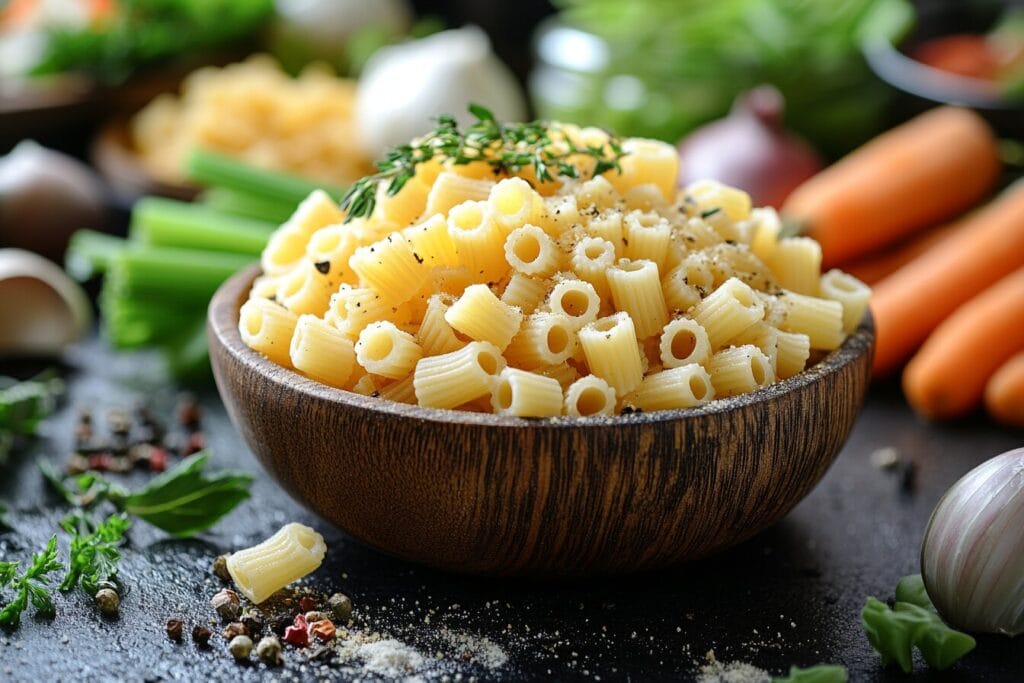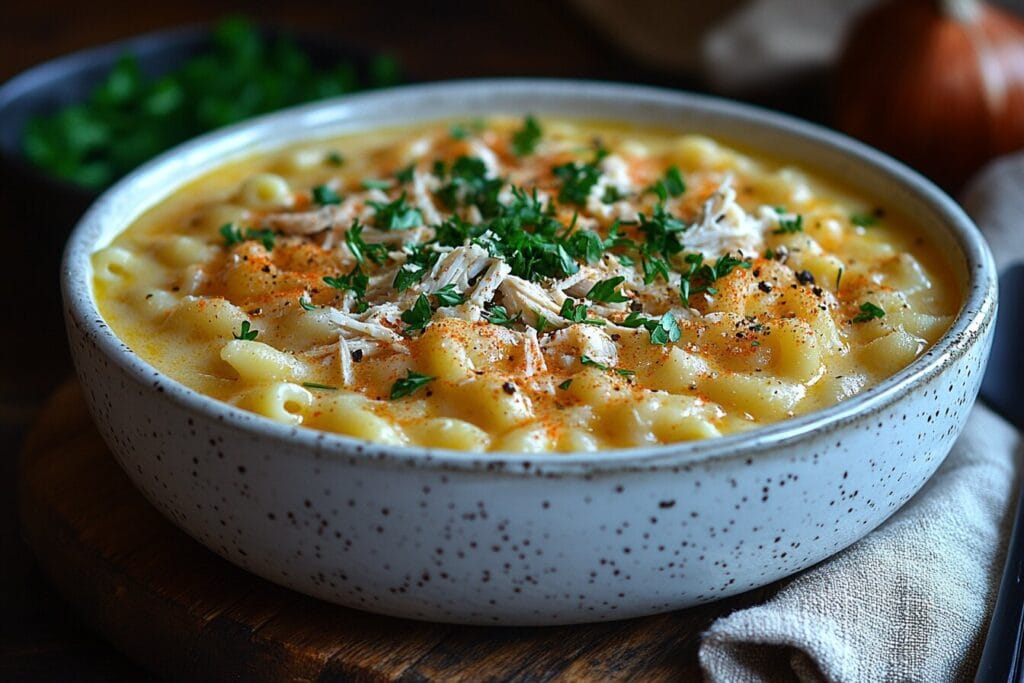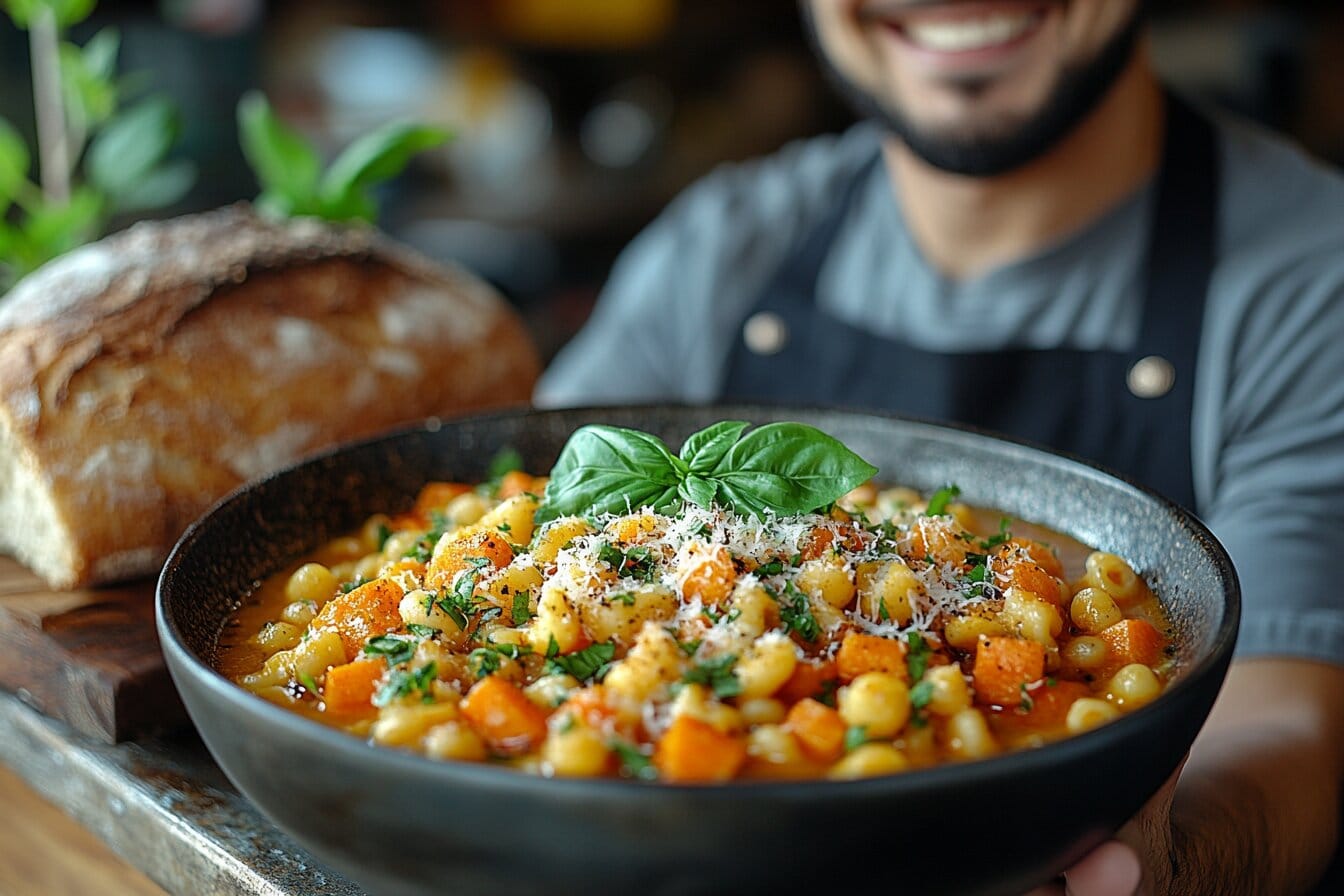Ditalini pasta soup is the epitome of comfort in a bowl. This humble yet versatile dish has the power to transform a dreary evening into a cozy retreat or elevate a family dinner with its heartwarming flavors. Whether you’re a seasoned chef or just starting out in the kitchen, ditalini pasta soup is a recipe that’s approachable, satisfying, and endlessly adaptable.
Picture this: a steaming bowl of tender pasta, fresh vegetables, and savory broth—simple ingredients coming together in perfect harmony. It’s more than just food; it’s a culinary embrace, a tradition passed down through generations, and a reflection of how food can bring people together. Whether you’re battling a winter chill or hosting a casual get-together, this soup is a guaranteed crowd-pleaser.
What makes ditalini pasta soup so special? Its beauty lies in its flexibility. You can keep it classic with a tomato-based broth, make it creamy and indulgent, or load it with veggies and beans for a nutritious twist. No matter the variation, it always delivers comfort and nourishment.
What is Ditalini Pasta Soup?
The History and Origins of Ditalini Pasta
Ditalini pasta, often referred to as “little thimbles,” hails from southern Italy, where it’s been a staple in hearty soups for centuries. Originally used to stretch meals during hard times, its small, tube-like shape has made it a favorite for soups because it’s easy to eat with a spoon.

Why Ditalini is Perfect for Soups
Ever wonder why ditalini pasta gets all the love in soups? It’s because of its bite-sized shape, which evenly distributes throughout the broth. Each spoonful is a perfect combination of pasta, veggies, and all those delightful flavors.
“Ditalini’s compact size makes it a superstar in soups, ensuring every bite is packed with texture and taste.”
Popular Variations of Ditalini Pasta Soup
Classic Italian Ditalini Soup
Think tomato-based broth, tender ditalini, and fresh basil. The classic version is simple but packed with flavor—like a warm hug from nonna.
Vegetarian and Vegan Ditalini Soup Recipes
Swap out the meat and use veggie broth, hearty beans, and seasonal vegetables for a plant-based delight that’s just as satisfying.
Creamy Ditalini Soup with Chicken or Sausage
For a richer take, add cream or cheese and toss in some protein like chicken or sausage. Trust me, the creamy texture takes this dish to the next level!

Ditalini Soup for Kids: Mild and Nutritious Options
Looking for a kid-friendly option? Use chicken broth, finely diced carrots, and a sprinkle of Parmesan. It’s mild, colorful, and fun for little ones to eat!
Essential Ingredients for Making Ditalini Pasta Soup
Choosing the Right Broth: Chicken, Vegetable, or Beef?
The base of your soup sets the tone for the entire dish. Chicken broth is a classic choice, vegetable broth keeps it light, and beef broth adds a robust flavor.
The Role of Fresh Vegetables in Enhancing Flavor
Veggies like carrots, celery, onions, and tomatoes not only add nutrients but also give the soup a balanced, wholesome taste. Want extra freshness? Throw in some chopped spinach or kale at the end.
Protein Choices for Ditalini Soup: Beans, Meat, and More
Cannellini beans or chickpeas are perfect for a vegetarian spin. For meat lovers, diced chicken, ground sausage, or even shredded beef are excellent options to bulk up your soup.
“Don’t skimp on the aromatics—garlic, onion, and herbs bring your soup to life!”
Step-by-Step Guide: How to Make Ditalini Pasta Soup
Preparing the Ingredients
Start by gathering everything you need. Here’s a quick checklist:
| Ingredient | Quantity |
|---|---|
| Ditalini Pasta | 1 cup |
| Olive Oil | 2 tbsp |
| Onion (diced) | 1 medium |
| Garlic (minced) | 3 cloves |
| Carrots (sliced) | 2 medium |
| Celery (sliced) | 2 stalks |
| Crushed Tomatoes | 1 can (15 oz) |
| Chicken/Vegetable Broth | 4 cups |
| Cannellini Beans | 1 can (rinsed) |
| Fresh Basil | Handful (chopped) |
| Parmesan Cheese | For topping |
| Salt and Pepper | To taste |
Cooking the Ditalini Pasta
Cook the ditalini pasta separately according to the package instructions. Drain and set aside. Cooking it separately prevents the pasta from absorbing too much broth and becoming mushy.
Combining Flavors for a Perfect Bowl
- Heat olive oil in a large pot over medium heat.
- Sauté onions, garlic, carrots, and celery until fragrant and slightly softened.
- Stir in crushed tomatoes and broth. Bring to a simmer.
- Add rinsed beans and cooked pasta to the pot.
- Simmer for another 10 minutes to meld the flavors.
- Toss in fresh basil just before serving.
- Ladle into bowls, top with Parmesan, and enjoy! 🍽
“Cooking pasta separately might seem like extra work, but it’s the secret to perfectly textured soup.”
Common Problems and Solutions in Ditalini Pasta Soup Making
Overcooked or Mushy Pasta: How to Prevent It
It’s all about timing. Cook your pasta al dente and add it to the soup just before serving. Alternatively, store the pasta and soup separately if making ahead.
Soup Too Salty? Quick Fixes You Can Try
Oops—too much salt? Add a splash of water, a peeled potato, or even a pinch of sugar to balance it out.
Bland Soup: Tips for Boosting Flavor
If your soup feels flat, try these tricks:
- Add a squeeze of lemon for brightness.
- Sprinkle in some red pepper flakes for a little heat.
- Toss in fresh herbs like parsley or thyme.
“Don’t be afraid to taste as you go. Seasoning is an art, not a science!”
Serving and Storing Ditalini Pasta Soup
Best Side Dishes to Pair with Ditalini Soup
What goes best with a steaming bowl of ditalini pasta soup? Crusty bread, garlic knots, or even a fresh side salad are perfect accompaniments. Want something extra cozy? Try pairing it with a grilled cheese sandwich—comfort food heaven!
How to Store and Reheat Leftovers Without Ruining Texture
Got leftovers? Store the soup and pasta separately to prevent the pasta from soaking up all the broth. When reheating, combine them in a pot and add a splash of broth or water if it’s too thick. Heat gently over medium heat and serve fresh!
Tips for Customizing Ditalini Pasta Soup
Gluten-Free Options for Ditalini Pasta Soup
If you’re avoiding gluten, swap out regular ditalini pasta for a gluten-free version made from rice or chickpeas. The flavor and texture are just as delightful!
Adding Spice for a Kick: Seasoning Suggestions
Love a little heat? Add crushed red pepper flakes, a dash of hot sauce, or even diced jalapeños for an extra punch of flavor.
Creative Garnishes to Elevate Your Soup Presentation
A sprinkle of Parmesan is a classic, but why stop there? Try crispy croutons, a dollop of pesto, or even a drizzle of flavored olive oil. Your soup will go from delicious to gourmet in seconds!
“The beauty of ditalini pasta soup is its versatility—you can tweak it to suit your cravings and dietary needs.”
Nutritional Benefits of Ditalini Pasta Soup
Healthy Ingredient Swaps
Want to make your soup even healthier? Use whole-grain ditalini for added fiber, or replace cream with coconut milk for a dairy-free twist.
Portion Control and Calorie Awareness
It’s easy to enjoy this soup guilt-free! Stick to reasonable portions, and pair it with a light side dish for a balanced meal. A typical serving of ditalini soup (without cream) is around 200-250 calories.
| Nutritional Facts | Per Serving |
|---|---|
| Calories | 220 |
| Protein | 9g |
| Carbohydrates | 32g |
| Fat | 7g |
| Fiber | 4g |
| Sodium | 580mg |
Ditalini Pasta Soup for Special Occasions
Comforting Winter Soups
When the weather outside is frightful, a bowl of ditalini pasta soup is oh-so-delightful. Its warmth and heartiness make it a go-to for cozy nights by the fire.
Hosting a Soup Party: Ideas and Tips
Ditalini soup is a fantastic choice for parties! Serve it alongside other soups in a buffet-style setup with toppings like grated cheese, fresh herbs, and croutons for guests to customize their bowls.
Frequently Asked Questions About Ditalini Pasta Soup
What Pasta is Best for Soup?
When it comes to soup, the type of pasta you choose can make or break the dish. Smaller pastas like ditalini, orzo, and small shells are ideal because they’re easy to eat with a spoon and evenly distribute throughout the soup. Their size allows them to soak up the flavors of the broth without overpowering the other ingredients. Ditalini, in particular, is a classic choice because of its tubular shape, which holds onto just the right amount of broth for a burst of flavor in every bite. For creamier soups, you might opt for slightly larger pasta like elbow macaroni, but always aim for shapes that balance well with your other ingredients.
“Small pasta shapes are the perfect companions for soup, ensuring every spoonful is a delightful mix of textures and flavors.”
What Was Dean Martin’s Favorite Soup?
Dean Martin, the legendary crooner and entertainer, was known for his love of Italian cuisine, and his favorite soup was none other than Pasta e Fagioli (commonly called “Pasta Fazool” in Italian-American slang). This hearty soup, made with beans, small pasta (like ditalini), and a rich tomato-based broth, perfectly embodied Martin’s Italian roots. It’s said that he often enjoyed this dish as a nostalgic reminder of his childhood in an Italian-American family. Just like his music, Pasta e Fagioli is timeless, comforting, and undeniably satisfying.
“Pasta Fazool wasn’t just Dean Martin’s favorite soup—it was a taste of home and heritage.”
What is the Difference Between Ditali and Ditalini Pasta?
Ditali and ditalini pasta are closely related, but their differences lie in their size. Ditali, meaning “thimbles” in Italian, are short, tube-shaped pastas that are slightly larger than ditalini. Ditalini, which translates to “little thimbles,” are the smaller, more delicate version of ditali. Both are excellent choices for soups, but ditalini is often preferred because its petite size blends seamlessly with other ingredients, making it easier to eat. Meanwhile, ditali might be used in chunkier soups or even pasta salads where a more substantial bite is desired.
“Think of ditalini as ditali’s younger sibling—smaller, but just as charming and versatile.”
What is the Difference Between Minestrone Soup and Pasta Fazool?
While both minestrone and Pasta e Fagioli (Pasta Fazool) are beloved Italian soups, they have distinct differences:
- Minestrone Soup: This is a vegetable-heavy soup, often made with seasonal veggies, beans, and pasta. It’s highly customizable and doesn’t always have a tomato base; it can be made with a light broth or even be cream-based. Minestrone is all about celebrating fresh ingredients and varies widely by region and season.
- Pasta Fazool: This soup focuses more on beans (usually cannellini or borlotti) and pasta in a tomato-based broth. It’s a thicker, heartier dish and is often seasoned with garlic, herbs, and sometimes pancetta for added depth. Pasta Fazool is simpler and more rustic compared to the vibrant medley of ingredients in minestrone.
“If minestrone is a garden in a bowl, Pasta Fazool is like a cozy countryside meal—simple, hearty, and full of soul.”
Conclusion: Why Ditalini Pasta Soup is a Must-Try Dish
Ditalini pasta soup isn’t just a meal; it’s an experience. From its rich history to its endless customization options, there’s a version of this soup for everyone. Its adaptability makes it ideal for a wide range of diets, and the ingredients are often staples in most kitchens, making it both affordable and convenient.
This soup has a way of bringing people together. Whether you’re enjoying it with family on a busy weeknight or sharing it with friends at a cozy dinner gathering, ditalini pasta soup offers a sense of warmth and connection. Plus, the ability to customize it ensures that no two bowls are ever exactly the same, adding a personal touch to every serving.
So, what are you waiting for? Grab those ingredients, experiment with flavors, and whip up a pot of ditalini pasta soup today. Your taste buds—and your loved ones—will thank you!

